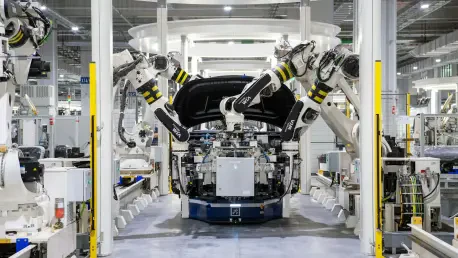In the heart of American manufacturing, a pressing challenge looms large: labor shortages are crippling production lines, with nearly 700,000 unfilled manufacturing jobs reported across the U.S. This staggering gap, compounded by rising operational costs, has pushed companies to seek innovative solutions to maintain competitiveness in an increasingly demanding market. Robotics automation has emerged as a beacon of hope, promising to bridge these gaps and revolutionize efficiency. Among the frontrunners in this transformative field is Formic, a Chicago-based provider of Full Service Automation solutions. This review dives deep into Formic’s cutting-edge technology, exploring how it addresses industry pain points and reshapes the manufacturing landscape with accessible, risk-free automation.
Unveiling Formic’s Core Innovations
Formic has carved a niche by tackling the traditional barriers to automation adoption head-on. The company’s flagship offering, the Full Service Automation model, eliminates the burden of high upfront costs and the need for specialized technical know-how. Manufacturers can integrate robotic systems with zero capital investment, paying only a flat monthly rate that covers equipment, maintenance, and performance optimization. This approach not only reduces financial risk but also ensures that businesses can scale operations without the fear of sunk costs.
A standout aspect of this model is its inherent flexibility. Formic allows customers to swap systems mid-contract, adapting to shifting production demands without penalty. Such adaptability is critical in an industry where needs can change rapidly due to market trends or seasonal fluctuations. By prioritizing ease of use and financial accessibility, Formic positions itself as a partner rather than just a provider, fostering trust among manufacturers hesitant about automation.
Expanded Offerings for Diverse Needs
Beyond its foundational model, Formic has broadened its portfolio to address a wider array of labor-intensive tasks. At a recent industry event, the company unveiled the Top Load Case Packer, a solution designed for end-of-line rigid package case packing—a task notorious for its ergonomic challenges. This innovation automates repetitive motions, reducing physical strain on workers while boosting packing efficiency.
Additionally, Formic introduced Floor Cleaning Robots tailored for industrial environments. These robots manage debris and maintain cleanliness in sprawling facilities, a mundane yet essential task that often diverts human labor from core production roles. Complementing these hardware solutions is Formic Production Intelligence (FPI), a cloud-based platform that delivers real-time data visibility. FPI empowers manufacturers with actionable insights, enabling data-driven decisions to optimize throughput and minimize downtime.
Each of these offerings underscores Formic’s commitment to holistic automation. By addressing not just production but also maintenance and operational oversight, the company ensures that manufacturers can tackle multiple pain points with a single, cohesive strategy. This comprehensive approach sets Formic apart in a market often focused on singular robotic applications.
Performance Metrics and Industry Impact
Formic’s robot fleet has achieved a remarkable milestone, surpassing 400,000 production hours—equivalent to over eight months of human labor per business day. This feat highlights the scale and reliability of Formic’s technology in real-world settings. Projections indicate the fleet will reach 500,000 hours by the end of the current year, cementing its status as one of the largest independent robotic fleets in the U.S.
This performance aligns with broader industry trends where automation is increasingly seen as a vital response to workforce shortages. Manufacturers are leaning toward integrated solutions that combine production enhancements with maintenance efficiencies. Formic’s ability to deliver consistent uptime and measurable labor savings reflects a growing reliance on robotics to sustain capacity in a constrained labor market.
The impact extends beyond raw numbers. By automating ergonomically taxing tasks, Formic’s solutions reduce workplace injuries and improve employee well-being. This dual benefit of operational efficiency and worker safety positions the technology as a cornerstone for modern manufacturing, addressing both economic and human-centric challenges.
Practical Deployments Across Manufacturing
In practical terms, Formic’s automation tools are making tangible differences across diverse U.S. manufacturing facilities. End-of-line packing, once a bottleneck due to its labor intensity, is now streamlined with robotic case packers that handle high volumes with precision. This application not only accelerates output but also frees human workers for more strategic roles.
Facility maintenance, often overlooked in automation discussions, benefits significantly from Formic’s Floor Cleaning Robots. These systems ensure consistent cleanliness in environments prone to debris accumulation, maintaining safety standards without diverting staff from critical tasks. Meanwhile, the FPI platform transforms raw data into strategic insights, enabling plant managers to preemptively address inefficiencies before they escalate.
Unique use cases further illustrate the versatility of Formic’s technology. For instance, in facilities with high turnover due to physically demanding jobs, automated systems have stabilized operations by taking over repetitive tasks. Such implementations demonstrate how Formic’s solutions adapt to specific industry needs, proving their value across varied manufacturing contexts.
Barriers to Widespread Adoption
Despite its advantages, robotics automation faces hurdles in achieving widespread adoption. A primary concern among manufacturers is the perceived complexity of integrating such systems, even with zero-capital-expenditure models like Formic’s. The fear of operational disruptions during implementation often deters smaller businesses from taking the leap.
Technical challenges also persist, including the need for seamless integration with existing workflows and potential regulatory constraints around workplace automation. Market barriers, such as limited awareness of accessible solutions, compound these issues, slowing the pace of adoption. Formic counters these concerns with 24/7 support and full maintenance services, ensuring minimal downtime and ongoing reliability.
Education remains a critical focus for overcoming hesitancy. Formic’s initiatives, such as hosting industry sessions on leveraging data for productivity and publishing comprehensive guides on automation, aim to demystify the technology. By fostering a deeper understanding of robotics’ benefits and practicalities, the company seeks to build confidence among prospective adopters, addressing cultural and informational gaps.
Looking Ahead at Automation’s Trajectory
The future of robotics automation in manufacturing appears poised for significant evolution. Innovations on the horizon, such as deeper integration of artificial intelligence and advanced data analytics, promise to enhance the precision and predictive capabilities of systems like Formic’s. These advancements could further optimize operational efficiency, allowing manufacturers to stay ahead of competitive pressures.
Formic’s role in democratizing automation is likely to set new benchmarks for the industry. By continuing to refine its zero-capital-expenditure model and expand its product suite, the company is well-positioned to influence how automation is perceived and implemented. The emphasis on accessibility could drive broader adoption, particularly among small and medium-sized enterprises previously excluded from such technologies.
Long-term, the impact of these developments may reshape manufacturing competitiveness on a national scale. As automation becomes less of a luxury and more of a standard, companies adopting solutions like Formic’s could gain a decisive edge. This shift suggests a future where operational scalability and workforce stability are no longer mutually exclusive, but instead mutually reinforced through strategic technology deployment.
Reflecting on Formic’s Contribution
Looking back, Formic’s journey in robotics automation stands as a testament to innovation tailored to real-world needs. The company’s milestones, from surpassing 400,000 production hours to introducing diverse solutions like case packers and data platforms, mark significant strides in addressing labor shortages and inefficiencies. Its commitment to education and community engagement further amplifies its influence, fostering a collaborative spirit within the industry.
For manufacturers contemplating the next steps, exploring partnerships with providers like Formic offers a practical pathway to transformation. Investing in automation with minimal financial risk provides an opportunity to test and scale solutions tailored to specific operational challenges. Engaging with educational resources and industry events hosted by such companies could also equip businesses with the knowledge to navigate this evolving landscape.
Beyond immediate adoption, the broader implication is clear: staying abreast of technological advancements in automation is essential for sustained growth. Manufacturers are encouraged to consider pilot programs or phased integrations to mitigate risks while reaping early benefits. As the industry continues to evolve, aligning with innovators who prioritize accessibility and support promises to be a strategic move for securing long-term resilience and competitiveness.









